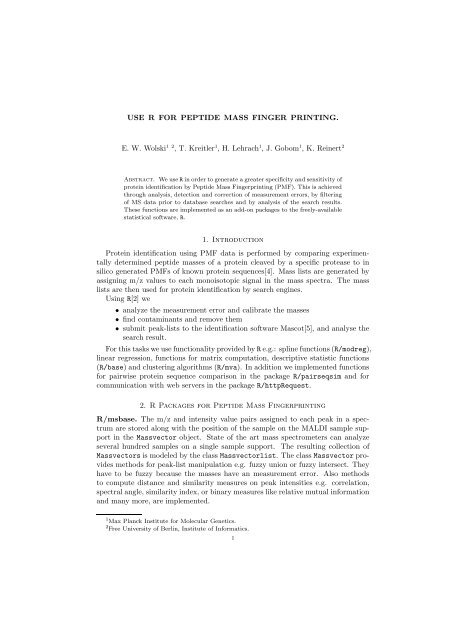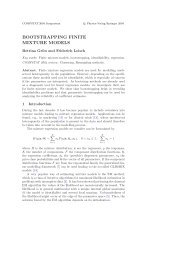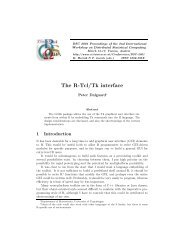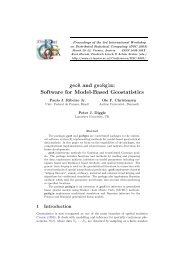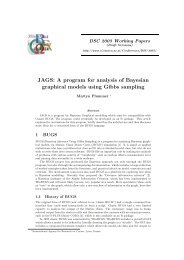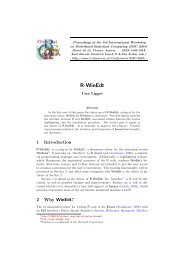Embedding R in Windows applications, and executing R remotely
Embedding R in Windows applications, and executing R remotely
Embedding R in Windows applications, and executing R remotely
Create successful ePaper yourself
Turn your PDF publications into a flip-book with our unique Google optimized e-Paper software.
USE R FOR PEPTIDE MASS FINGER PRINTING.<br />
E. W. Wolski 1 2 , T. Kreitler 1 , H. Lehrach 1 , J. Gobom 1 , K. Re<strong>in</strong>ert 2<br />
Abstract. We use R <strong>in</strong> order to generate a greater specificity <strong>and</strong> sensitivity of<br />
prote<strong>in</strong> identification by Peptide Mass F<strong>in</strong>gerpr<strong>in</strong>t<strong>in</strong>g (PMF). This is achieved<br />
through analysis, detection <strong>and</strong> correction of measurement errors, by filter<strong>in</strong>g<br />
of MS data prior to database searches <strong>and</strong> by analysis of the search results.<br />
These functions are implemented as an add-on packages to the freely-available<br />
statistical software, R.<br />
1. Introduction<br />
Prote<strong>in</strong> identification us<strong>in</strong>g PMF data is performed by compar<strong>in</strong>g experimentally<br />
determ<strong>in</strong>ed peptide masses of a prote<strong>in</strong> cleaved by a specific protease to <strong>in</strong><br />
silico generated PMFs of known prote<strong>in</strong> sequences[4]. Mass lists are generated by<br />
assign<strong>in</strong>g m/z values to each monoisotopic signal <strong>in</strong> the mass spectra. The mass<br />
lists are then used for prote<strong>in</strong> identification by search eng<strong>in</strong>es.<br />
Us<strong>in</strong>g R[2] we<br />
• analyze the measurement error <strong>and</strong> calibrate the masses<br />
• f<strong>in</strong>d contam<strong>in</strong>ants <strong>and</strong> remove them<br />
• submit peak-lists to the identification software Mascot[5], <strong>and</strong> analyse the<br />
search result.<br />
For this tasks we use functionality provided by R e.g.: spl<strong>in</strong>e functions (R/modreg),<br />
l<strong>in</strong>ear regression, functions for matrix computation, descriptive statistic functions<br />
(R/base) <strong>and</strong> cluster<strong>in</strong>g algorithms (R/mva). In addition we implemented functions<br />
for pairwise prote<strong>in</strong> sequence comparison <strong>in</strong> the package R/pairseqsim <strong>and</strong> for<br />
communication with web servers <strong>in</strong> the package R/httpRequest.<br />
2. R Packages for Peptide Mass F<strong>in</strong>gerpr<strong>in</strong>t<strong>in</strong>g<br />
R/msbase. The m/z <strong>and</strong> <strong>in</strong>tensity value pairs assigned to each peak <strong>in</strong> a spectrum<br />
are stored along with the position of the sample on the MALDI sample support<br />
<strong>in</strong> the Massvector object. State of the art mass spectrometers can analyze<br />
several hundred samples on a s<strong>in</strong>gle sample support. The result<strong>in</strong>g collection of<br />
Massvectors is modeled by the class Massvectorlist. The class Massvector provides<br />
methods for peak-list manipulation e.g. fuzzy union or fuzzy <strong>in</strong>tersect. They<br />
have to be fuzzy because the masses have an measurement error. Also methods<br />
to compute distance <strong>and</strong> similarity measures on peak <strong>in</strong>tensities e.g. correlation,<br />
spectral angle, similarity <strong>in</strong>dex, or b<strong>in</strong>ary measures like relative mutual <strong>in</strong>formation<br />
<strong>and</strong> many more, are implemented.<br />
1 Max Planck Institute for Molecular Genetics.<br />
2 Free University of Berl<strong>in</strong>, Institute of Informatics.<br />
1


